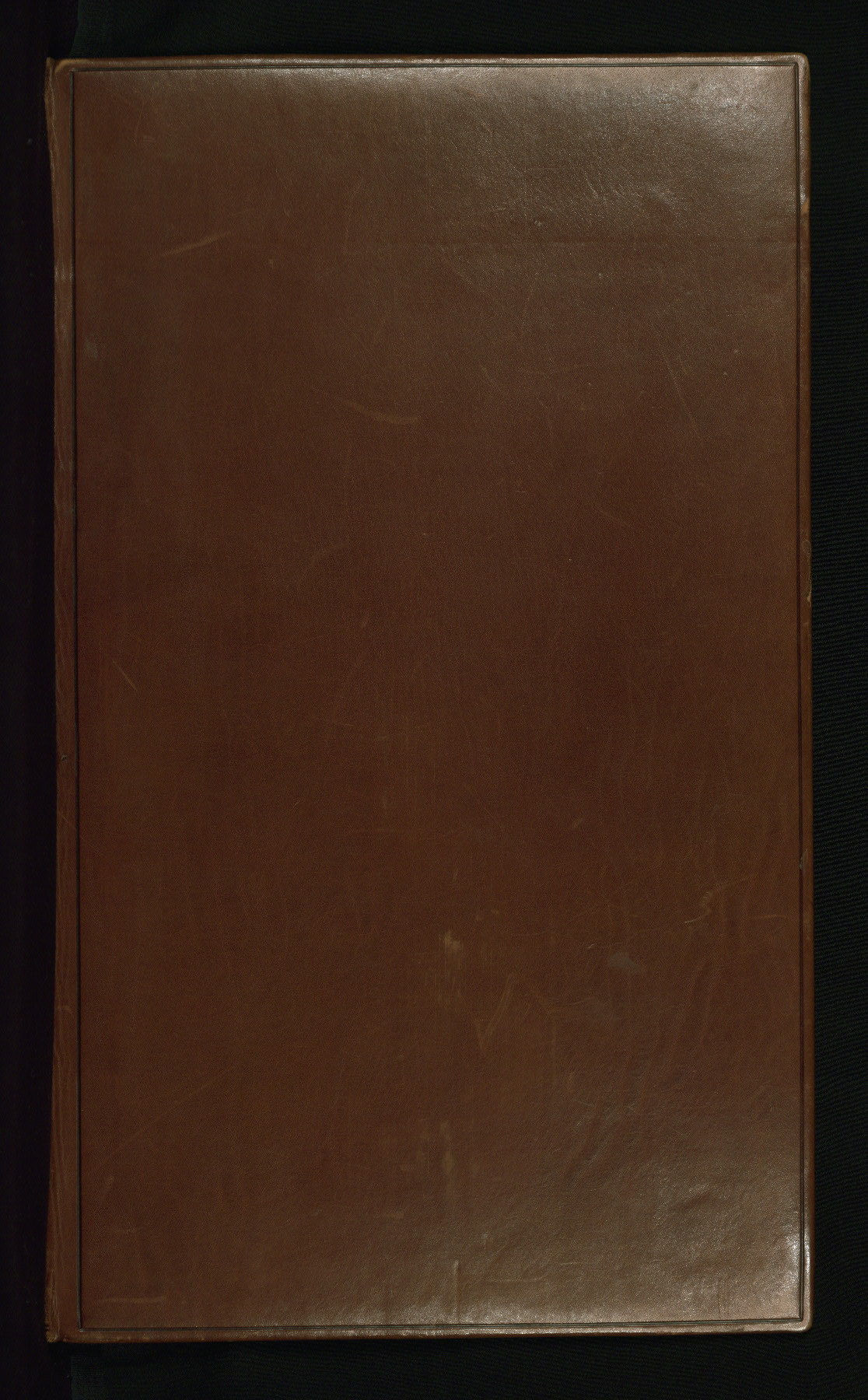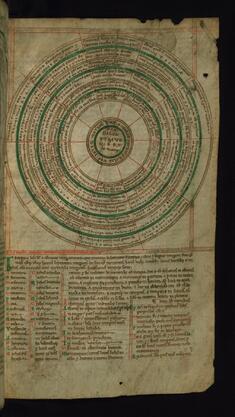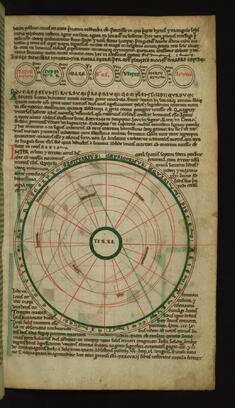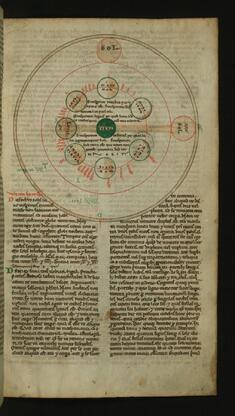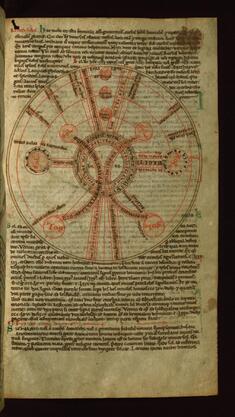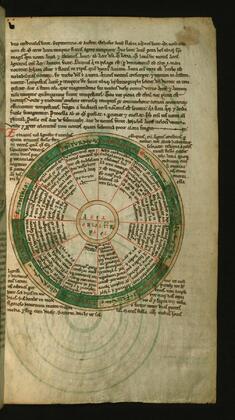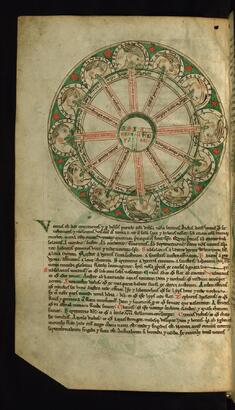Cosmography
(Manuscripts and Rare Books)
Created in England in the late twelfth century, this manuscript was intended to be a scientific textbook for monks. The manuscript is brief at nine folios, and was designed as a compendium of cosmographical knowledge drawn from early Christian writers such as Bede and Isidore, as well as the later Abbo of Fleury. Those writers, in turn, drew on classical sources such as Pliny the Elder for their knowledge but adapted it to be understood through the filter of Christianity. The twenty complex diagrams that accompany the texts in this pamphlet help illustrate them, and include visualizations of the heavens and earth, seasons, winds, tides, and the zodiac, as well as demonstrations of how these things relate to man. Most of the diagrams are rotae, or wheel-shaped schemata, favored throughout the Middle Ages for the presentation of scientific and cosmological ideas because they organized complex information in a clear, orderly fashion, making this material easier to apprehend, learn, and remember. Moreover, the circle, considered the most perfect shape and a symbol of God, was seen as conveying the cyclical nature of time and the Creation as well as the logic, order, and harmony of the created universe. England is especially notable for the production of illustrated scientific textbooks, with the earliest examples produced during the Carolingian period under the influence of the noted Benedictine scholar Abbo of Fleury, who taught at Ramsey Abbey for two years. Although the grouping of texts and diagrams here is unique, the manuscript is related to other scientific compilations from this era, such as British Library, Royal Ms. 13 A.XI, Cotton Ms. Tiberius E.IV, and Oxford, St. John's College, Ms. 17.
Provenance
Provenance (from the French provenir, 'to come from/forth') is the chronology of the ownership, custody, or location of a historical object. Learn more about provenance at the Walters.
Gruel and Englemann Collection, Paris [1]; acquired by Henry Walters, Baltimore, 1903; by bequest to Walters Art Museum, 1931.
[1] no. 131, bookplate on inside upper board
Exhibitions
| 2024 | Healing the Body, Healing the Soul. The Walters Art Museum, Baltimore. |
| 2013 | Living by the Book: Monks, Nuns, and Their Manuscripts. The Walters Art Museum, Baltimore. |
| 2009 | Pen and Parchment: The Art of Drawing in the Middle Ages. The Metropolitan Museum of Art, New York. |
| 2001-2002 | Expanding World Views: A Millennium of Maps. The Walters Art Museum, Baltimore. |
| 1992 | A World of Foreign Lands. The Walters Art Gallery, Baltimore. |
| 1988 | Heavenly Bodies. The Walters Art Gallery, Baltimore. |
| 1986 | Text and Image: Medieval Book Illustration. The Walters Art Gallery, Baltimore. |
| 1984-1985 | Illuminated Manuscripts: Masterpieces in Miniature. The Walters Art Gallery, Baltimore. |
| 1977-1978 | Splendor in Books. Grolier Club, New York; The Walters Art Gallery, Baltimore. |
Measurements
Overall H: 10 3/4 x W: 6 7/16 x D: 3/8 in. (27.3 x 16.4 x 0.9 cm); Folio H: 10 1/2 × W: 6 1/8 in. (26.7 × 15.5 cm)
Credit Line
Acquired by Henry Walters, 1903
Location in Museum
Not on view
Accession Number
In libraries, galleries, museums, and archives, an accession number is a unique identifier assigned to each object in the collection.
In libraries, galleries, museums, and archives, an accession number is a unique identifier assigned to each object in the collection.
W.73
Do you have additional information?
Related Objects
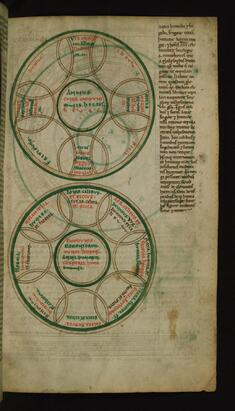
Diagrams of the harmony of the Year and Seasons, and the Harmony of the Elements, Seasons and Humors
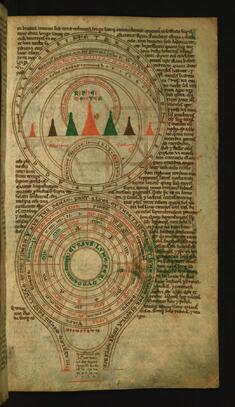
Diagrams of the Terrestrial Climate Zones with the Riphaean Mountains and the Circuit of the Moon in the Zodiac
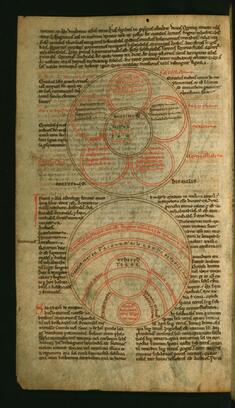
Diagrams of the Celestial Climate Zones and Terrestrial Climate Zones


